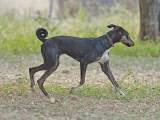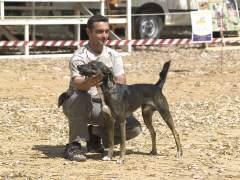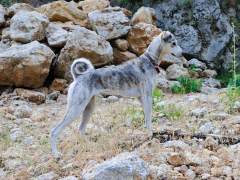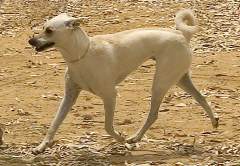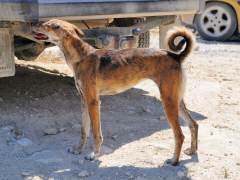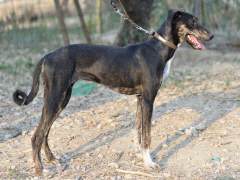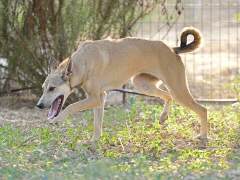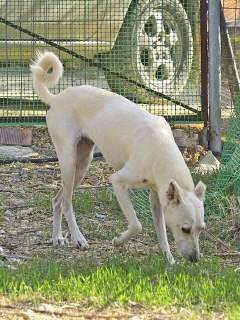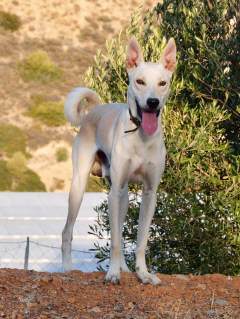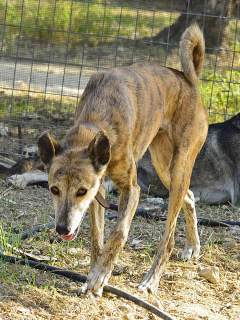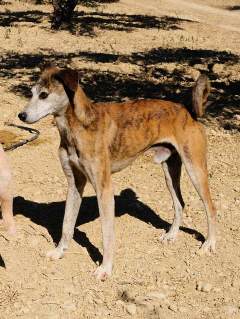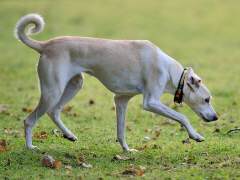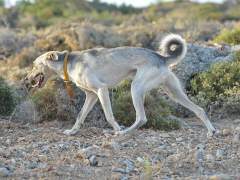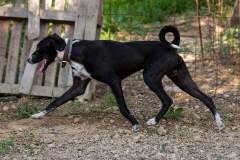Breed standard english
Breed standard Cretan Hound
The first breed standard for the Cretan Hound has been written in 2003 in Greek and English by Maria Ginala, recognized judge for the breed and was basically for the recognation of the breed in Greece by the K.O.E. (Kennel Club of Greece). In Germany the Cretan Hound is recognized since 2015. In January 2019 the new breed standard was published, written by the Cretan Hound Club Crete (OKLA) in collaboration with the K.O.E. and the standard commission of the FCI.
Kritikos Lagonikos / Cretan Hound
ORIGIN: Greece, Crete Island
DATE OF PUBLICATION OF THE OFFICIAL VALID STANDARD: 16.01.2019
UTILIZATION: Hound used from centuries for the hunting of small and medium sized game, mostly for hare.
FCI-CLASSIFICATION: Group 5: Spitz and Primitive types.
Section 7: Primitive type - Hunting Dogs
With working trial.
BRIEF HISTORICAL SUMMARY: Ancient Dog, originating from Crete Island. Its origin is testified by a large number of artworks representation found in prehistoric settlements of Crete before the Minoan culture (3.200-1700 B.C.).
Sealing stones, ceramic and metallic utensils, ornamental objects, sculptures and frescos of continuous historic periods give unchanged the figure of the Cretan Hound (Museum of Heraklion).
GENERAL APPEARANCE: Primitive type hound of medium size, slim, athletic, fast. Short coated, with long legs, rectangular body, wedge-shaped head, curled tail.
IMPORTANT PROPORTIONS: The body is slightly longer than the height at the withers. Chest can reach the elbow level. Legs are longer as the depth of the chest. The length of the muzzleis slightly shorter or equal tothe length of the skull.
BEHAVIOUR/TEMPERAMENT: Smart, noble, dashing in hunting, persistent, brave, and with endurance. Mild, obedient, excellent companion and muchattached with family. Theycan be reserved with the strangers but never aggressive. He searches using all senses following scent by ground and air, flushes out the game and pursuits rushing with exceptional agility. Gives tongue, sharp and rather low volume at the visual detection of the game and its pursuit. In ancient times he was considered to be excellent at hunting deer, wild boar and bear.
HEAD
CRANIAL REGION:
Skull: Trapezoid shape. Top of the skull is slightly curved and wide. Seen from profile the skull is rather flat. Bridge bonesare medium developed. The length of the skull is slightly longer than the width of the skull.
Wedge shaped, elongated. Cranial axes nearly parallel. Seen from the front, skull is slightly curved, quite wide, with smooth but visible stop; frontal furrow is marked between the eyes and progressively decreasing towards the top of the skull. Occiput is slightly pronounced.
Stop: Smooth but visible.
FACIAL REGION:
Nose: Quite big, dump, elastic and with well opened nostrils. Dark colored nose is to be preferred. In brown colored specimens a dark brown nose is accepted.
Muzzle: The muzzle is slightly shorter or equal to the skull. Wedge shaped, relatively big with straight bridge nose tapering smoothly towards the nose.
Lips: Lips are thin, tight and black, without slackness.
Jaws/Teeth: Strong jaws with complete normal dentition. Scissor bite. Level bite accepted. Teeth well developed and healthy, the opening of the mouth and lips is deep.
Cheeks: Slightly curved, converging straight forward.
Eyes: Medium sized, slightly almond shaped, placed forward and slightly oblique. The color of the eyes should be dark. Good pigmentation of eyelids.
Ears: “V” shaped, slightly rounded at the tip. Medium sized, triangular, wide at the base, high and slightly sideways set, pointing forward.
Skin must be thin, with very high mobility, lively half erect or erect. Depending on the situation, the dog moves them, turning them to the sides or back, folds them touching the neck (rose ears). Cropping is forbidden.
NECK: Dry neck, strong, slightly arched.
BODY:
Top line: Broken top line, the second part slightly convex.
Withers: Well marked, visible withers.
Back: Strong, very well sustained in movement, with moderate muscle definition
Loin: Loins are strong, with good muscle definition, with length nearly equal to the depth.
Croup: Moderately long, not too wide, never sloppy (between 40°- 45° angle), with good muscle definition but not exaggerated. The top of iliac bones is slightly visible.
Chest: Enough deep, reaching the elbow, moderately wide, ring ribs but never too rounded. The brisket must be oval in section with wellspriggedribs, but never barrel-shaped, giving though enough space for the lungs. Well-developed fore chest.
Underline and belly: Tucked up underline but not exaggerated (whippety)
TAIL: Middle height set, reaches almost the hocks. It is wide at the base, thinning down towards the end. Carried upwards in a curve, half circle or curved on the rear with a moderate hook at the end. When at ease it is let down and is straight without distortions.
LIMBS:
FOREQUARTERS: Long shoulder blades, laid back, muscular but not bulky. Upper arm is nearly equal to scapula with a moderate scapula-humeral angle. Limbs are straight, sinewy and long, with oval shaped, strong but not heavy bones. Strong carpus but not too wide, metacarpus is elastic and slightly inclined.
General appearance: Forelegs straight and parallel.
Shoulder: Shoulder strong, long and well laid back.
Upper arm: Well developed, making a moderate angle with the blade.
Elbow: Elbows close to the body, never going in or out.
Carpus (Wrist): Width, thickness.
Metacarpus (Pastern): Strong Pasterns, seen from the side slightly oblique.
Forefeet: Big feet, oval shaped, with long and strong toes andstrong pads with curved and strong nails.
HINDQUARTERS:
General appearance: Strong and muscular. Limbs parallel when viewed from behind.
Thigh: Well developed with good muscles, wide, of a good length.
Stifle (Knee): Moderate bend of stifle.
Lower thigh: Lower sight well developed.
Hock joint: Strong, stable in movement.
Metatarsus (Rear pastern): Straight, not too wide, perpendicular to the ground.
Hind feet: Oval but a little bit longer than the front feet, with strong toes and nails and well developed pads. Dewclaws arehighly undesirable.
GAIT / MOVEMENT: The movement is light, effortless, fast and gracious stride with smooth steps, without crossing of the legs. The dog has the tendency to a quick change from the elastic/springy trot in a low speed to a fast gallop, having great ease to change directions.
SKIN: Thin, quite tight, durable, without wrinkles and looseness, with good pigmentation.
COAT:
Hair: Smooth, hard, totally straight, dense, very short and thin at the head, ears and lower part of the body, slightly longer at the crest of the neck, the rear and the tail. Length must not be longer than 2,5 cm but not shorter than 1,5 cm on the body. The hair is longer on the tail.
Color: All colors from white to black are acceptable as well as any combinations.
SIZE AND WEIGHT:
Height at the withers: Males: 54-58 cm Females: 52-56 cm (with a tolerance of +-2 cm).
Weight: Males: 16-22 kg Females: 14-20 kg
FAULTS:
Any departure from the foregoing points should be considered a fault and the seriousness with which the fault should be regarded should be in exact proportion to its degree and its effect upon the health and welfare of the dog and its ability to perform its traditional work.
SEVERE FAULTS
- Severe depigmentation of nose, eyelids and lips
- Albinism
- Over or undersized length of coat under 1, 5 cm. or longer than 2,5 cm
- Overshot or undershot bites
DISQUALIFYING FAULTS
- Aggressive or overly shy dogs
- Dog clearly showing physical or behavioral abnormalities shall be disqualified
- Untypical specimen
- Overshot or undershot bites more than 2 mm
- Dewclaws
N.B.:
- Male animals should have two apparently normal testicles fully descended into the scrotum
- Only functionally and clinically healthy dogs, with breed typical conformation, should be used for breeding
>>> weiter (next) Protypo fylis Ellinika
<<< Zurück (back) Rasse-Standard Deutsch

